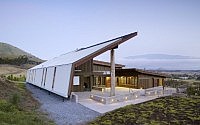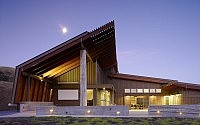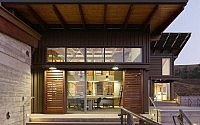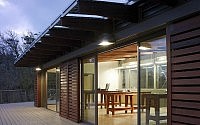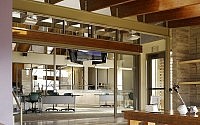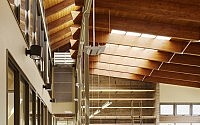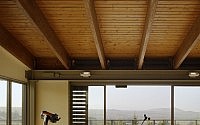Hawaii Preparatory Academy by Flansburgh Architects
In Kamuela, Hawaii, Flansburgh Architects designed a new contemporary science building for the Hawaii Preparatory Academy.








Description by Flansburgh Architects
In this new 6,100 square foot renewable-energy research laboratory, students will study, design, and evaluate renewable-energy technologies. The award-winning facility meets the Living Building Challenge, a threshold that exceeds the USGBC’s Platinum LEED rating. It produces all of its own energy needs, harvests rainwater to meet its potable water needs, and provides natural ventilation and views to 100% of its occupied spaces. Sophisticated energy models were used to form the shape and fenestration of the building during the design.
The Energy Lab was developed in response to the science curriculum it houses. From small project rooms, to a large research center, to a laboratory, spaces were designed to encourage student discovery, exploration and experimentation. The building’s configuration facilitates scientific study both indoors and out, linking interior spaces with the surrounding landscape. Students are surrounded by the systems that they study, and constantly reminded of their methods. Hawaii Prep’s Energy Lab offers a continuous sustainable ‘teaching moment’.
The building is a LEED Platinum and Living Building Challenge candidate. It attempts two exceptionally strict building programs, the latter applying material restrictions and point-of-manufacture radius limits. The building generates all power from photovoltaic and windmill sources. It presently uses only eight percent of the energy it produces, the remainder being net-metered back into the campus grid. The building captures and filters all of its own drinking and wastewater, and generates hot water from solar thermal panels. The building is entirely naturally ventilated, and employs an experimental radiant cooling system as an alternative to air conditioning. There are many other green features but perhaps the greatest sustainable contribution is the building’s alternative energy educational mission where students actively learn from the built environment that surrounds them.
Daylighting, Sun Shading & Views: Polycarbonate skylights, wood sun screens, and interior roller shades all work together to introduce, reflect and control natural day light. These components were strategically employed to satisfy foot candle minimums, tackle glare, and enhance views, resulting in a pleasantly lit interior environment.
Natural Ventilation: The building is entirely naturally ventilated. Building automated louvers maintain temperature and relative humidity levels to maintain interior comfort. If necessary exhaust fans are activated to induce airflow.
Experimental Radiant Cooling System: As an alternative to conventional air conditioning, a radiant cooling system was designed. At night water is circulated through thermal roof panels, cooled via lower evening temperatures, then stored in a below-grade tank for use as a chilled water for air handling units during warm afternoons.
Integration with the Site: Located at the windward edge of campus to take full advantage of the abundant trade winds that accelerate down from the hillside above. The site faces due south to picturesque 14,000 foot Mauna Kea volcano. Due southern exposure optimizes solar thermal and photovoltaic panel performance and enables many interior building views directed toward the volcano and valley below. Given the favorable Hawaiian climate and the building’s dramatic hillside setting direct connections to the outdoors are enhanced via operable glass doors. An entry court is located to the east, a large teaching porch opens directly south, and a wind sheltered court to the west sponsors and outdoor, covered classroom. The topography of the hillside is reflected in the stepped, terraced arrangement of the building’s internal spaces, where storage tanks, solar panels and other systems have been strategically located to take advantage of this change in elevation.
Integration with the Community: The Elab online, the facility’s website, is a virtual nexus of information. The site tracks local weather data from multiple remote stations, monitors building systems and energy use, studies water consumption and rain collection, and offers all of this valuable microclimate and building data to neighboring residents of Kamuela and to the virtual community beyond. The Energy Lab’s conference room has been designed to take advantage of Hawaii’s bridge between the West Coast and Asian Mainland time zones. Where formerly Hawaii may have suffered from geographical isolation, Hawaii Prep students now benefit by engaging both sides of the pacific during their regular school day via video conferencing.
Building Systems Monitoring: Developed to function much like the human brain, the Energy Lab is capable of regulating its breathing, cooling/heating, watering and energy generation, via input from over 250 sensors. The Energy Lab self-regulates its interior climate, maintaining temperature, relative humidity, and carbon dioxide levels in all spaces at all times. Truly a marvel, this system optimizes building performance and is believed the reason for better than anticipated yields in performance thus far.
- by Matt Watts